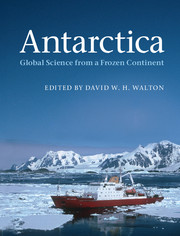Book contents
- Frontmatter
- Contents
- List of contributors
- Introduction
- 1 Discovering the unknown continent
- 2 A keystone in a changing world
- 3 Ice with everything
- 4 Climate of extremes
- 5 Stormy and icy seas
- 6 Life in a cold environment
- 7 Space science research from Antarctica
- 8 Living and working in the cold
- 9 Scientists together in the cold
- 10 Managing the frozen commons
- 11 Antarctica: a global change perspective
- Appendix A Visiting Antarctica
- Appendix B Further reading
- Acknowledgements
- Index
11 - Antarctica: a global change perspective
Published online by Cambridge University Press: 05 March 2013
- Frontmatter
- Contents
- List of contributors
- Introduction
- 1 Discovering the unknown continent
- 2 A keystone in a changing world
- 3 Ice with everything
- 4 Climate of extremes
- 5 Stormy and icy seas
- 6 Life in a cold environment
- 7 Space science research from Antarctica
- 8 Living and working in the cold
- 9 Scientists together in the cold
- 10 Managing the frozen commons
- 11 Antarctica: a global change perspective
- Appendix A Visiting Antarctica
- Appendix B Further reading
- Acknowledgements
- Index
Summary
The natural world is the greatest source of excitement; the greatest source of visual beauty; the greatest source of intellectual interest. It is the greatest source of so much in life that makes life worth living.
David AttenboroughAntarctica has been separated from the other continents for at least 30 million years. It is largely a frozen, barren continent with over 99% of its surface covered by ice, up to 4.5 km thick. It is the highest, driest, windiest and coldest continent and has the least vegetation and terrestrial life both in quantity and diversity. By complete contrast the Southern Ocean that surrounds Antarctica is rich in marine life, supporting many iconic species, including whales, seals, penguins and albatrosses. Antarctica has provided a remarkably stable environment over recent geological time and hence the physiological functions of many of its native marine species are now extremely sensitive to very modest changes in temperature. Antarctica is therefore considered to be one of the most fragile areas on Earth, and therefore most vulnerable to the effects of climate change.
Antarctica is at the very end of the Earth, yet human activity is having a significant impact on its environment. Changes in atmospheric circulation arising from the impacts of humans elsewhere are causing regional effects such as the break-up of ice shelves, marked changes in sea ice concentrations in the southern Pacific Ocean and Ross Sea areas, and reductions in krill concentrations in the South Atlantic. These are all associated with increased carbon dioxide emissions and the effects of the Antarctic ozone hole.
- Type
- Chapter
- Information
- AntarcticaGlobal Science from a Frozen Continent, pp. 301 - 324Publisher: Cambridge University PressPrint publication year: 2013



